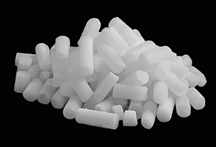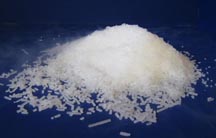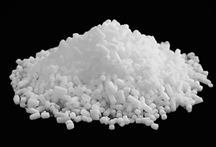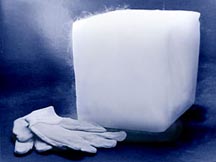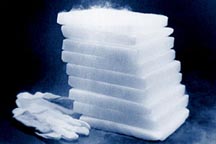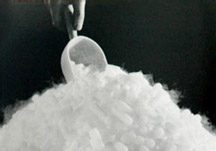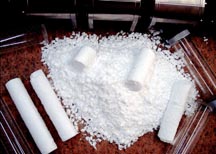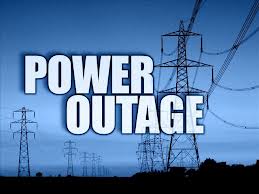
POWER OUTAGE
If the electricity is out for a brief period of time keep the refrigerator and freezer closed and everything will be all right. The time everything will stay frozen or cool will depend on the type of freezer or refrigerator, the thermostat setting, and the temperature surrounding the appliance. Generally speaking on a hot summer day after the first hour, for every hour off, an equivalent day of storage will be lost for refrigerated items. Three to six hours could represent two to five days of storage. For the freezer, depending on how full it is, (the more full the better) things will stay frozen from three to six hours in a refrigerator freezer and up to twelve hours for a chest freezer.
ONLY TAKE ACTION IF THE POWER IS EXPECTED TO BE OFF FOR A LONGER PERIOD OF TIME!
Follow the directions for each appliance below:
FREEZER NOT WORKING
Do not touch Dry Ice directly. Use insulated gloves, potholder, towel, etc. Use the following guidelines for each type of freezer. For each 24-hour period:
(1) Freezer on bottom: use 15 to 25 pounds.
(2) Freezer on top: use 20 to 30 pounds.
(3) Side by side Freezer: use 30 to 40 pounds. Place each slab, starting with the top shelf, on top of the food to be kept frozen. Bottom shelves will be kept frozen by the Dry Ice above it.
(4) Chest Freezer: use 40 to 50 pounds. When taking out the frozen food, carefully lift the dry ice slab up with gloves, potholder, towel, etc., without touching the dry ice directly.
REFRIGERATOR NOT WORKING
For each 12 to 24 hour period, place a ten pound slab of Dry Ice on bottom shelf of the refrigerator to cool. Do not touch Dry Ice with bare hands. Do not place it directly on the glass shelf, but use newspaper or other insulated protection between the Dry Ice and the shelf. When the Dry Ice is sublimated replace it with a new slab. Keep extra Dry Ice in an ice chest. Because Dry Ice is frozen CO2, it will carbonate open containers. Carbonated water is OK but carbonated milk sure tastes different! Also anything too close to the Dry Ice may freeze. Watch out for items below the bottom shelf as they may freeze too. Regular block ice is better for the refrigerator - the old fashion "ice box" - but then the melted ice water must be removed.
DISPOSAL
When finished with the Dry Ice, unwrap and leave it at room temperature in a well-ventilated area. It will sublimate from a solid to a gas. DO NOT leave Dry Ice unattended around children. If you would like a fantastic simulated volcano, run hot water and put the remainder Dry Ice in your garbage disposal. Use safety goggles and stand back. This will make a marvelous eruption.
WALK-IN FREEZER
A 12x12 walk in freezer will use 150 to 250 pounds per day. If the fans are running, place half the Dry Ice as high and close to the back of the evaporator unit where the air is sucked through. Place remainder slabs on top shelves directly on frozen food. Leave door open when entering the freezer. Carbon dioxide gas will accumulate in lowest areas and could cause suffocation. Use the buddy system with one person outside the walk-in at all times to help remove items from the walk-in. Leave walk-in if you start to pant and breath quickly or your fingernails or lips start to turn blue. This is the sign that you have breathed in too much CO2 and not enough oxygen.
WALK-IN REFRIGERATOR
A 12x12 walk in refrigerator will use 50 to 100 pounds per day. If the fans are running, place all the Dry Ice as high and close to the back of the evaporator unit where the air is sucked through. Otherwise, place slabs on top shelves without touching any food. Too much Dry Ice will lower the temperature too much and freeze food near the floor. Monitor the temperature closely after several hours. Add or subtract Dry Ice as needed. Keep extra Dry Ice in an ice chest. Leave door open when entering walk-in. Carbon dioxide gas will accumulate in lowest areas and could cause suffocation. Use the buddy system with one person outside the walk-in at all times to help remove items from the walk-in. Leave walk-in if you start to pant and breath quickly or your fingernails or lips start to turn blue. This is the sign that you have breathed in too much CO2 and not enough oxygen.
We provide dry ice products such as: Pellets, Rice Pellets (Dry Ice Blasting), Micro Pellets, 1/4 inch , Special Cut Blocks, Slices, Nuggets and High Density Dry Ice.
